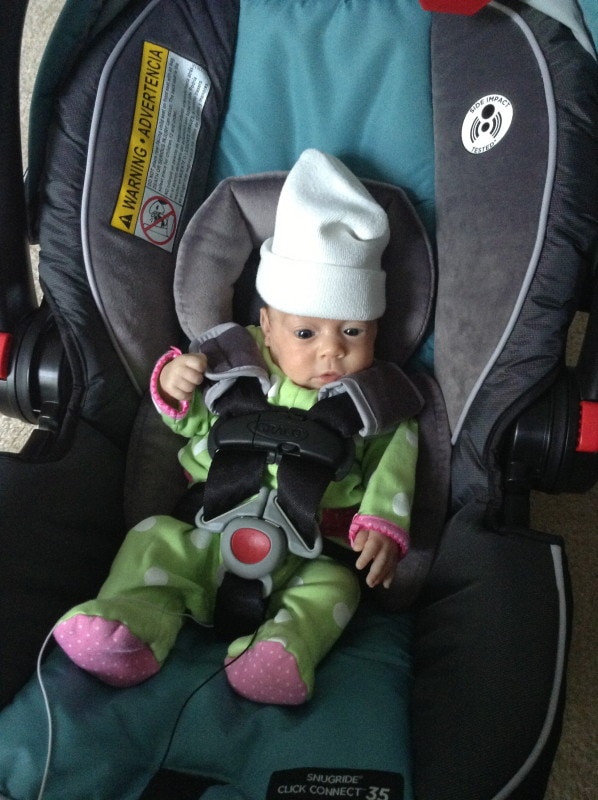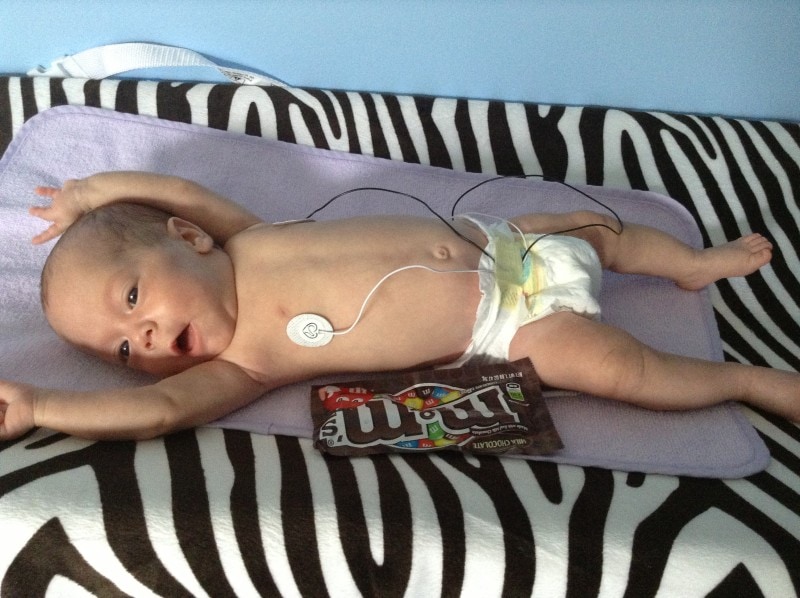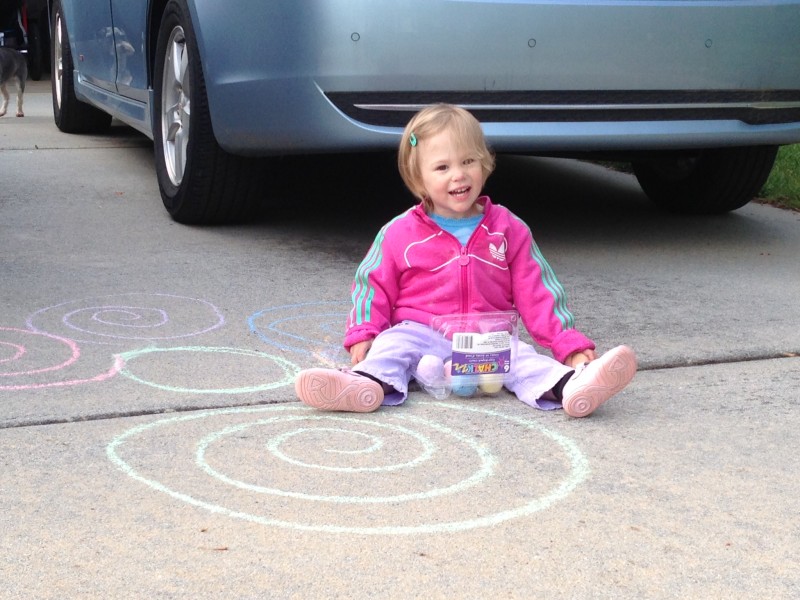Bringing Our Preemie Home
By Lisa Tandan, author of the blog A-Belle Growing Up: A Micro-Preemie Adventure
Writing about having a preemie at home implies comparison, but here’s the thing: I don’t know what it’s like to have a term baby at home. Our preemie is our first and only. That in itself has been a blessing and (not quite) a curse: I don’t know which things we’ve experienced are typical and which are not. Though I do know that there is no normal when it comes to kids, I still have found myself wondering: how would it have been different if we’d had a healthy term baby?
 After ten and a half weeks in the NICU at Novant Health Forsyth Medical Center, our 1lb 12oz preemie, born at 26 weeks gestation, came home on July 31st, 2013. Her car seat easily dwarfed her at her coming home weight of only 4lbs and 13oz. But, we were assured that she had met the milestones required for her release: she could breathe on her own, eat from a bottle, and maintain her body temperature. This is true for term babies, too—the hospital won’t send you home with a baby who can’t master these three skills; ours just spent the time needed to develop these in the hospital, instead of in the womb.
After ten and a half weeks in the NICU at Novant Health Forsyth Medical Center, our 1lb 12oz preemie, born at 26 weeks gestation, came home on July 31st, 2013. Her car seat easily dwarfed her at her coming home weight of only 4lbs and 13oz. But, we were assured that she had met the milestones required for her release: she could breathe on her own, eat from a bottle, and maintain her body temperature. This is true for term babies, too—the hospital won’t send you home with a baby who can’t master these three skills; ours just spent the time needed to develop these in the hospital, instead of in the womb.
Like many micro-preemies, Alannah came home with prescription equipment. We had a hospital grade monitor for her heartbeat and breath, which would alert us if she were to have “episodes” – bradycardia, where her heart would beat dangerously slow, or apnea, where she would stop breathing. This seems different, but many parents purchase equipment to monitor their term babies. Had I not witnessed hundreds of episodes in the hospital, would I have purchased equipment? I don’t know.
Since Alannah had already spent almost 3 months adjusting to being on the “outside”, she came home on a schedule—and so did we! After 73 days on the every 3 hour NICU schedule, we were in a routine, and we kept it. Every three hours we changed and fed our daughter, and then I obsessively logged it all in the Baby Connect app. Would I have had a schedule and tracked all of her input and output (and, let’s be honest, I also took her temperature every three hours for a month, too), if we hadn’t learned to do that in hospital? Some parents do.
 Alannah came home with appointments already on the books: the first was her follow-up with the eye doctor to evaluate her for Retinopathy of Prematurity (ROP). After she was given the all-clear, the next visit was with her new Child Developmental Services Agency (CDSA) caseworker, who comes to our home once a month to evaluate Alannah’s progress, a service she automatically qualified for based on her gestation at birth. Only about 30%-40% of babies born at Alannah’s gestation do not experience a developmental delay or physical disability, depending on the data set you’re reviewing. But, some term babies also qualify for CDSA, and others need the interventions later on; would we have needed services anyway?
Alannah came home with appointments already on the books: the first was her follow-up with the eye doctor to evaluate her for Retinopathy of Prematurity (ROP). After she was given the all-clear, the next visit was with her new Child Developmental Services Agency (CDSA) caseworker, who comes to our home once a month to evaluate Alannah’s progress, a service she automatically qualified for based on her gestation at birth. Only about 30%-40% of babies born at Alannah’s gestation do not experience a developmental delay or physical disability, depending on the data set you’re reviewing. But, some term babies also qualify for CDSA, and others need the interventions later on; would we have needed services anyway?
There is one thing that is certainly unique to the preemie experience: Alannah came home with two ages. The actual age, which is how old she is from birth, and her adjusted age, which is how old she would be if she were born on time (think of this age as from conception to now). I’ve found that this tends to stump most people. The constant comparisons between parents are a challenge: what age did your child walk? When did your daughter start talking?  The answer is: I’m not sure, but she did it. The actual and adjusted ages only matter in the first two years when we are measuring development by months—once we start measuring in years, these handful of months won’t matter. But right now, if you go by actual age, she’s behind on everything: she rolled over around 6 months and walked at 17 months. But if you go by her adjusted age: she rolled over at 3 months and walked at 14 months. If she were born on time, with the full benefit of 9 months in utero, would she have walked earlier? I don’t know. But, one thing is for sure, I wouldn’t have minded if she’d waited a few more months before making me chase her! Click HERE to read a recent post that Lisa wrote about Alannah’s “adjusted age.”
The answer is: I’m not sure, but she did it. The actual and adjusted ages only matter in the first two years when we are measuring development by months—once we start measuring in years, these handful of months won’t matter. But right now, if you go by actual age, she’s behind on everything: she rolled over around 6 months and walked at 17 months. But if you go by her adjusted age: she rolled over at 3 months and walked at 14 months. If she were born on time, with the full benefit of 9 months in utero, would she have walked earlier? I don’t know. But, one thing is for sure, I wouldn’t have minded if she’d waited a few more months before making me chase her! Click HERE to read a recent post that Lisa wrote about Alannah’s “adjusted age.”
These questions could go on forever, if I let them. Instead, as I rock Alannah at bed time, I marvel at how sturdy she is in my arms. At two years old (actual) on May 20th, Alannah’s not big in size, but she’s big in spirit and personality. I think back to how tiny she was when I first held her in the NICU; she could fit in my bra! As I relish the quiet moment, I remember that I’m not the only mom rocking her child to sleep, amazed at how far she has come.
Read more about Lisa’s NICU experience HERE in her personal blog, as well as her past TMoM post HERE.

Thank you so much for this blog. Alannah is beautiful and it is amazing to see how far she has come!